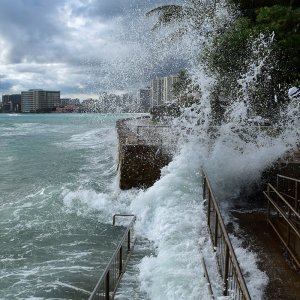
Hawai‘i Sea Grant helps coastal communities prepare for natural disasters
August 19, 2019
(Honolulu, HI) – The University of Hawaiʻi Sea Grant College Program (Hawaiʻi Sea Grant) recently released the Guidance for Disaster Recovery Preparedness in Hawaiʻi which aims to help coastal communities recover from disasters even before they strike.
The guidance document is intended to help State and county agencies establish recovery practices and protocols before a disaster hits to enable communities to recover quickly while also improving resilience to future disasters, adapting to climate change and sea-level rise, and protecting sensitive environments.
Dr. Brad Romine, Hawai‘i Sea Grant coastal management and resilience specialist and leader of this project, said “It is no secret that our shorefront development is highly vulnerable to hurricanes and other events. Impacts from flooding, high waves, and erosion will worsen in coming decades with sea level rise and other climate change related effects. Our emergency management agencies are well-prepared and have worked tirelessly in their response to recent disasters. However, we need to improve our preparedness, particularly for longer-term recovery and rebuilding following a disaster. Disasters provide critical windows of opportunity and funding for improving resilience to future disasters and changing conditions with climate change and sea level rise. Plans and policies need to be in-place before disaster strikes so we build back safer and smarter.”
Climate Commission emphasizes importance of pre-disaster recovery plans
The twenty-member Hawai‘i Climate Change Mitigation and Adaptation Commission (Climate Commission), which includes experts from the University of Hawai‘i at Mānoa, highlighted the importance of developing recovery plans and policies before disastrous events occur, and showed their support for this guide by adopting a new written recommendation at the July 2019 meeting. The new recommendation was added to an earlier five-point statement on sea-level rise adaptation, and states:
“Encourage all State and county agencies together with community to develop, strengthen, and expand pre-disaster recovery plans and policies that incorporate opportunities to adapt to climate change and sea level rise through disaster recovery.
Suzanne Case, co-chair of the Climate Commission and chair of DLNR, noted “Collaborations like this through the Climate Commission can bring relevant expertise and resources, like the new guide that was rolled out at this month’s meeting. It is imperative that Hawai‘i prepare as much as possible for increasing impacts of coastal storms with climate change and sea-level rise, and the addition to the Commission’s statement reinforces that.”
The publication was developed in partnership with the State of Hawai‘i Department of Land and Natural Resources (DLNR) and Office of Planning (OP), as well as Tetra Tech, Inc., with funding support from the National Oceanic and Atmospheric Administration (NOAA).
This guide and a companion Guidance for Addressing Coastal Hazards and Sea Level Rise in Community Planning (in development, due April 2020) are examples of interagency and interdisciplinary collaboration and resulting tools needed to prepare Hawai‘i for climate change and sea-level rise, and form a critical next step towards a more

